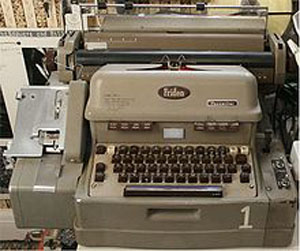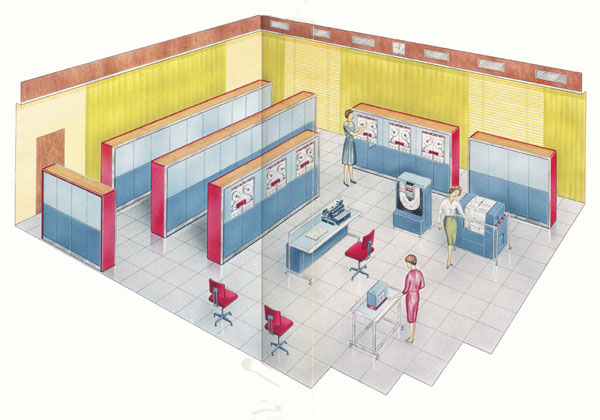When I tell people I’ve worked in the computer industry for almost fifty years, they think for a while, and usually say “We didn’t have computers fifty years ago.”
And if they’re really nice people, they’ll add “But you don’t look old enough.” Ha!
Well, technically, the Antikythera mechanism was an ancient mechanical computer designed to calculate astronomical positions. It was recovered from a shipwreck in Greece in 1901, and is believed to be at least 3000 years old. But, I suppose these days, when we say “computers” we think of the modern digital programmable devices. The first one of those, Colossus, was built in 1943, without which, the outcome of WWII might have been quite different. Its raison d’être was to decipher teleprinter messages that had been encoded by the Germans. At least ten were in use by the end of the war, and for those early days of the computer industry, that was a large number.
In 1943, Thomas J. Watson – then Chairman and CEO of IBM – is supposed to have said…
“I think there is a world market for maybe five computers.”
Whether or not he really said this, it does reflect the thinking of the time, and is probably the reason why people now think there were no computers fifty years ago. There were, but there were very very few, and they were hugely expensive.
My interest in computers was fueled by reading the one computer book in the school library, yes, just one – A Guide to Fortran Programming by Daniel D. McCracken. Surprisingly it’s still available at amazon.com, although I can’t imagine why anyone would want to read it. I would have thought it more of a museum piece these days, commanding a high price, but Amazon says “9 used from $3.81.” So I guess they’re about as valuable as my Fortran programming expertise!
I began my career within a few weeks of leaving school in 1964, becoming a Trainee Programmer with English Electric Computers, which at the time was part of the huge English Electric engineering group. The company went through so many mergers and acquisitions, and its name changed so many times, that I almost forgot which company I was working for. Whatever is left of it, is now part of Fujitsu.

By 1964, computers were well into their “second generation” with row upon row of printed circuit boards, containing transistors and tiny rings of iron surrounded by coils of wiring known as “core” memory. Although archaic by today’s standards, they offered a degree of reliability far above their vacuum tube-based predecessors – or “first generation” computers.
Even so, reliability was a major issue … and that gave me my first big career challenge.
At that time, and for decades afterward, no one would believe that any computer could be better than, or even as good as, an IBM. There was a saying that no computer manager was ever fired for buying IBM, and it was probably true. The KDF9, the computer I first gained experience of, was ideally suited to the computing needs of large organizations. But private organizations bought IBM, while the British Government twisted the arms of public institutions to buy from English Electric. One of those institutions was Birmingham University in the British Midlands.

The university was not going to accept their KDF9 without a fight. They insisted on a one year acceptance trial, during which the computer had to achieve a certain percentage of reliability. I don’t recall the exact figure, but it was quite high. I had completed basic training, and I think – for no other reason than the fact Birmingham was quite close to my home town – it was decided I should go work there to help look after the KDF9 and generally to keep the university people happy.
Up until that point I had been at a place called Kidsgrove, which is the “K” in KDF9. The “D” stood for development … so all of the computer models were KD-something. The “F” was added after a long meeting to decide the official name of the system, when in exasperation the Director shouted, “I don’t care what the F*** you call it.” 🙂
The year and a bit I spent at Birmingham University was a huge challenge. But at least, when someone asks – with that attitude that universities matter – “What university did you go to?” – I can honestly answer “Birmingham.” It seems to impress that type of person, and I don’t have to admit I didn’t actually study there. Although I probably learned far more about life and computing than any student.
There were only two of us on the management side, and my boss spent most of his time at head office. So being in charge of a multi-million pound computer system at the tender age of twenty, was quite daunting.
Actually, while at the university I kind-of had two different jobs. The official acceptance test was a 9 to 5 task, because those were the official university hours. Everything that happened to the computer had to be logged – especially any down time. Every part had to be accounted for and anything that was repaired or replaced had to be documented. Any anomoly, like a program not producing expected results, had to be analyzed and explained, in case it was caused by a computer malfunction. Usually it was a program error, but it took a great deal of diplomacy to explain this to a university staff member whose first words were usually “If I’d run this on an IBM…”
But at 5pm, I turned into a computer operator, something I’d never been trained to do, but picked-up fairly quickly. Paper tapes had to be loaded, magnetic tapes mounted, printouts removed from printers and paper replaced as needed. It was easier to do these thing wrong rather than right, and many of my initial attempts resulted in a few miles of paper or tape ending up on the floor. But eventually it became second nature.

Communicating with the computer was done with something having the bizarre name of a Friden Flexowriter. Really, it was just an electric typewriter, with a bi-colored ribbon. An operator could press a tab switch to gain control to type some coded instruction to the computer, which appeared in black type, or the computer could type some kind of instruction to the operator, which appeared in red. It was all fairly simple stuff like “mount tape xyz on drive 2” and the operator would confirm when that was done.
Although not part of the official test, the computer was used out of hours to help graduate students run their programs, and since they weren’t allowed to touch the computer, they needed a volunteer operator. The Computer Room was off limits to mere programmers and students. For me, the extra experience was good, and the overtime pay helped fund my rally career.
And when that was all over, at the end of the evening, the computer was often used for several hush-hush operating system and compiler tests, that the university never knew about. So, the days were long.

But, I enjoyed those evenings, especially when working alone. Being in a room filled with cabinets of state-of-the-art equipment, watching the numerous flashing lights to understand what the program was doing and what point it had reached (many ran for hours) was quiet surreal. I used to turn off the computer room lighting … working in whatever light came through the glass panel that allowed people to peer into the goldfish bowl, plus the flashing lights on the cabinets.
But one evening, things became a little too surreal…
I was running a long program, feeling in tune with everything the computer was doing, when suddenly I realized everything was slowing down. It seemed strange, because a computer either worked, or it didn’t. It didn’t steadily slow down, to the point where there was a sudden burst of typing on the Flexowriter, followed by all the tape reels stopping and the flashing lights becoming steady, and then an eery silence.
I wandered over to the Flexowriter, not expecting to see anything meaningful because I assumed this was all some unexplained malfunction. But, in red letters, I found the words…
I S L E E P
Somewhat stunned, I hit the power button, waited for everything to wind down, locked-up and went home.
Next morning the two resident engineers were waiting for an explanation. “Wanted an early night, did you?” they said accusingly. “Hey, it was 10:30pm. What do you mean, early?” I replied. “The computer typed that” I explained, to howls of laughter.
Okay. If I’d been in their shoes I would have reacted the same way. They were forty-something highly-experienced engineers, listening to a computer rookie, who was just twenty, trying to convince them a computer had typed something meaningful in English.
But the anomaly had to be logged and explained. I have no idea how they did that. I just know it was the strangest thing that has happened in almost fifty years worth of computing experiences. I couldn’t explain it then, and I can’t now.
